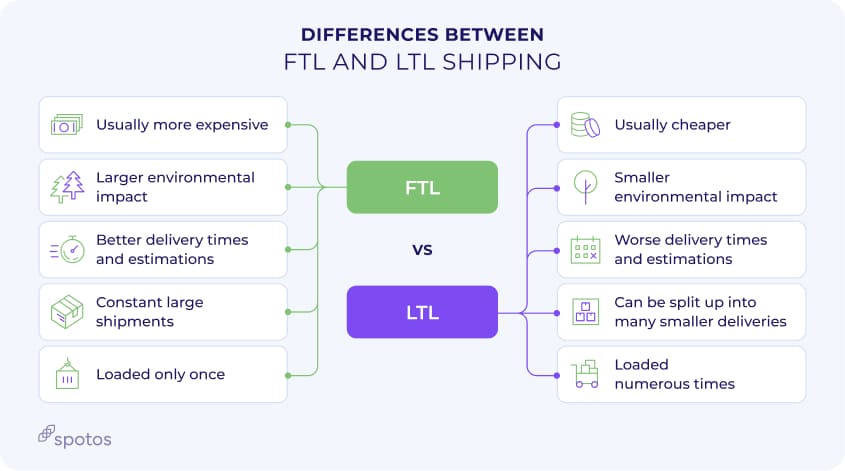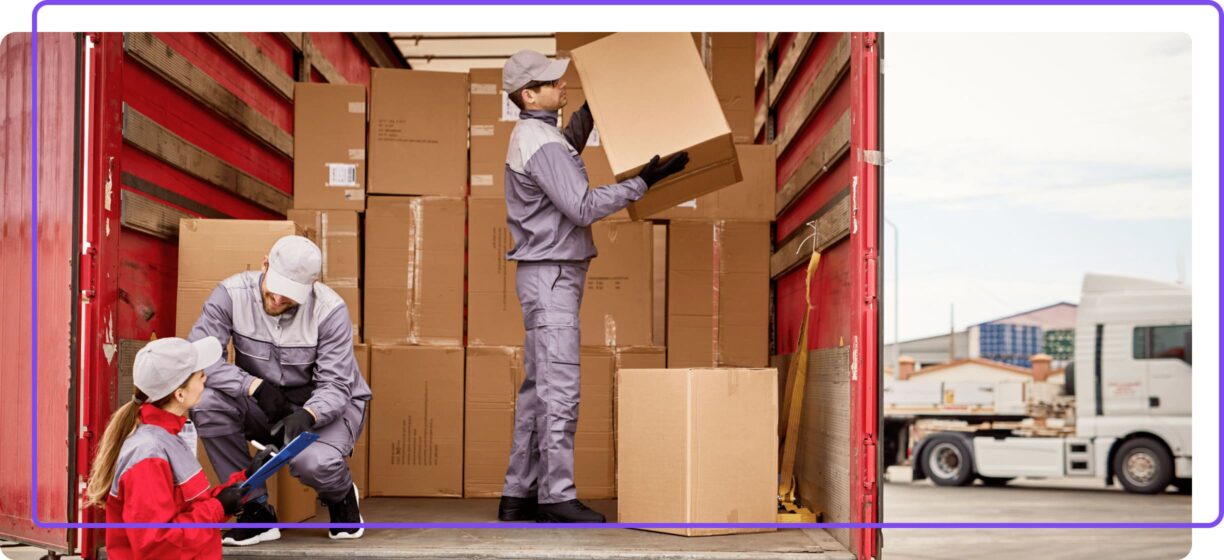Both full truckload (FTL) and less-than-truckload (LTL) freight shipping options appear in logistics. These terms define the freight shipping process and how companies carry it out. Both types have different costs and arrangements. Likewise, you need to grasp their differences if you intend to use either FTL or LTL freight shipping.
What is FTL shipping?
FTL is an acronym for “Full Truckload Shipping.” Sometimes referred to as TL (Truckload Shipping). It’s what you would expect – FTL freight from a single business occupies the entire truck.
FTL freight shipment means full delivery to the intended destination. Important to mention this cargo is independent, i.e., the whole truck is reserved by one company. The critical advantage of full truckload shipping is complete control over shipment. This type of shipping is the best option for sensitive goods. Such as pharmaceutical products, which need careful transportation.
What is LTL shipping?
LTL stands for “Less-Than-Truckload.” This refers to small shipments as they only cover part of the space in semi trucks. In general, it usually means several small loads are added up together onto a single freight.
The payments usually depend on occupied space in the truck. This is why pricing has become more flexible. It depends on the number of pallets and the freight’s size.
What is the difference between LTL and FTL shipping?

Five aspects distinguish LTL from FTL shipping: cost margin, environmental impact, delivery times, warehousing, and load frequency.
Cost differences
FTL and LTL truckload carriers may differ in their pricing models across companies. Besides, the LTL is almost cost savings choice. Sending out a few pallets means occupying little space within the truck.
Environmental impact
LTL shipping is carpooling for goods, so it has a lesser environmental impact.
On the other hand, reserving an entire truck without taking up all its space is a waste. So LTL will always have a lesser footprint in these cases.
The only exception to the rule is when the FTL shipping method completely covers the truck. Then there is no difference in environmental impact.
Delivery times
FTL shipping picks up the freight and delivers it to the intended destination. Unlike, LTL has to make stops at several locations, which means that delivery times will almost always be longer.
Additionally, FTL shipping often has better estimates as fewer Force Majeure factors exist. However, each stop a truck has to make reduces prediction accuracy, so LTL shipping is less reliable.
Warehousing
LTL and FTL shipping impact warehousing. Consistent LTL smaller shipments will often be less stressful. As moving products around is more effortless. Full truck shipments always bring extensive delivery, which can cause storage issues.
Load frequency
Finally, the minor point is that FTL shipping loads and unloads the truck only once. As a result, LTL shipping has to move around goods to make room for new ones. Also, it unloads only partly at multiple locations, meaning there’s a higher risk of damage to fragile or sensitive products.
When to choose FTL shipping?
FTL is primarily used when your freight covers the entire truck. While you can send smaller freight through FTL, it’s not recommended as the costs will be much higher than with LTL. A rule of thumb could be to choose (for prices only) FTL when you send more than six pallets at a time.
Additionally, consider the requirements of your freight. Fragile or sensitive products are almost always best shipped with FTL. It reduces the amount of loading and, in turn, risks.
Finally, FTL is best if you have tight schedules and delivery dates. It’s often faster and more accurate. So you can make better predictions for your entire business chain. In short:
- Freight covers a full truckload
- Products are sensitive or fragile
- Tight delivery schedules
- Warehousing is not an issue
When to choose LTL shipping?
Going back to the rule of thumb, if you ship less than six pallets at a time, LTL shipments will often be the better option. In that case, costs are significantly lower than using full truckload shipments.
LTL can be a better option if your delivery times are more flexible and products are not fragile. Also, splitting them up into several LTL shipments can ease warehousing issues.
Finally, LTL freight is a better solution if your business is environmentally conscious. It has a smaller footprint. Yet, splitting up a truckload into several smaller ones might negate environmental benefits. In short:
- Freight only covers part of the truckload
- Budgetary constraints
- Products are not sensitive or fragile
- Business is environmentally conscious
Frequently asked questions
Less-than-truckload shipping is most often used by businesses that:
- Carry robust products that are not sensitive to movement or temperatures
- Freight does not cover the entire truckload
Additionally, some companies choose LTL shipping to lessen environmental impact.
Full truckload shipping is popular among businesses that can cover an entire truckload.
Also, companies operate with fragile products.
Additionally, some prefer FTL shipping due to better delivery times and estimations. They are allowing those businesses to make better predictions.
At extremely optimal conditions, LTL can be equally as fast as FTL. However, LTL will almost always be slower in practice because trucks stop at numerous locations to unload the freight. Several stops increase the likelihood of human error, making delivery date predictions harder.
As a rule, anything less than six pallets is considered LTL. In practice, LTL is any amount of freight that does not cover an entire truckload.
If the freight does not cover the entire space in the truck, then LTL will almost always be cheaper. FTL becomes cheaper when cargo can protect the truckload or is extremely close to doing so.
